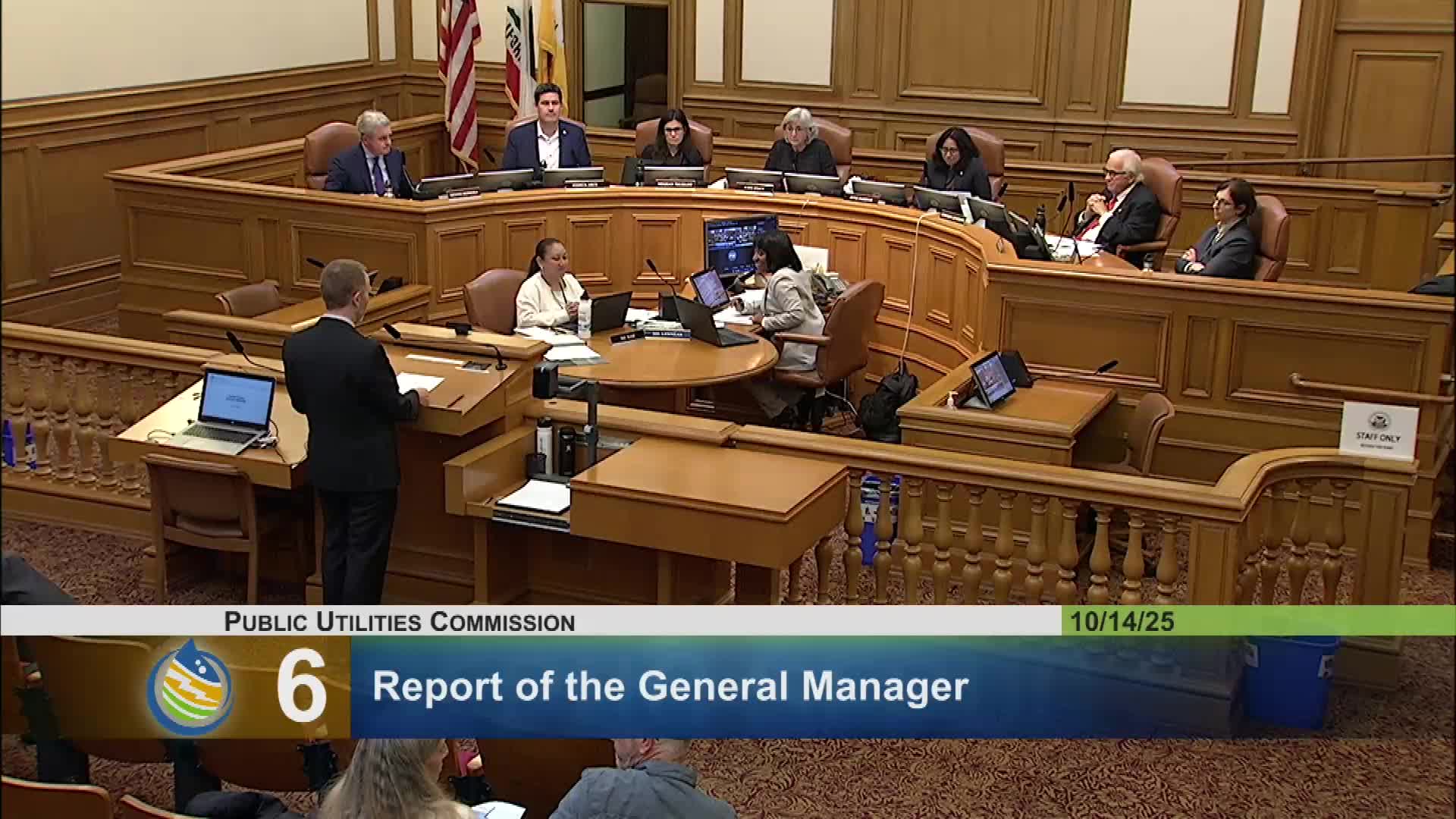SFPUC staff brief commissioners on capital project delivery methods and use of progressive design-build
October 14, 2025 | San Francisco City, San Francisco County, California
This article was created by AI summarizing key points discussed. AI makes mistakes, so for full details and context, please refer to the video of the full meeting. Please report any errors so we can fix them. Report an error »

At an informational item, Assistant General Manager for Infrastructure Stephen Robinson presented an overview of the San Francisco Public Utilities Commission’s capital project delivery methods and the rationale for selecting among them for different projects.
Robinson described the main delivery methods used by the SFPUC: job order contracts (JOCs) and as‑needed contracts for smaller or routine work; traditional design‑bid‑build for many projects; and collaborative/alternative methods such as construction management/general contractor (CMGC), design‑build, and progressive design‑build for larger or more complex projects. He emphasized there is no single method that fits every project and that method selection depends on project objectives, complexity, size, technical constraints and desired outcomes such as schedule certainty or cost control.
Robinson presented SFPUC data showing most projects by number are design‑bid‑build, while larger-dollar projects sometimes use collaborative methods. He described how CMGC brings a contractor on earlier (roughly 35–65% design) to add constructability input; design‑build places design and construction under one contract; and progressive design‑build brings the contractor on very early with price evolving as trade packages are bid to allow “design to budget” and potential schedule acceleration.
Commissioners asked about inclusive procurement and whether progressive or other models increase opportunities for local and micro‑LBE (local business enterprise) contractors. Robinson said delivery method can influence procurement levers: progressive approaches and CMGC provide more opportunities to negotiate phasing, break projects into trade packages and emphasize workforce and local participation, but execution also depends on contract language and partnership with the city’s contract monitoring division. He and staff said additional sessions will cover LBE hiring mechanics and programmatic approaches.
Commissioners also asked whether staff has in‑house expertise to manage progressive design‑build projects; Robinson said SFPUC has some internal expertise and will continue to use outside owner’s advisors and programmatic consultants when needed. He noted progressive design‑build is being used more often for complex projects in the capital plan (examples cited: nutrient project and others) and staff will return with more detail about governance, gateways and how contract phases will be presented to the commission so incremental awards do not appear as change orders.
Robinson flagged recent SFPUC performance metrics (five‑year window) showing a higher share of projects met schedule and budget thresholds compared with some industry studies, and he said collaborative methods are part of the toolbox to continue improving outcomes. He offered to follow up with a more detailed workshop on progressive design‑build and a briefing focused on LBE outcomes and workforce goals.
No formal action was required; the item was an informational briefing and commissioners asked staff to bring additional workshops on procurement inclusivity and progressive design‑build governance.
Robinson described the main delivery methods used by the SFPUC: job order contracts (JOCs) and as‑needed contracts for smaller or routine work; traditional design‑bid‑build for many projects; and collaborative/alternative methods such as construction management/general contractor (CMGC), design‑build, and progressive design‑build for larger or more complex projects. He emphasized there is no single method that fits every project and that method selection depends on project objectives, complexity, size, technical constraints and desired outcomes such as schedule certainty or cost control.
Robinson presented SFPUC data showing most projects by number are design‑bid‑build, while larger-dollar projects sometimes use collaborative methods. He described how CMGC brings a contractor on earlier (roughly 35–65% design) to add constructability input; design‑build places design and construction under one contract; and progressive design‑build brings the contractor on very early with price evolving as trade packages are bid to allow “design to budget” and potential schedule acceleration.
Commissioners asked about inclusive procurement and whether progressive or other models increase opportunities for local and micro‑LBE (local business enterprise) contractors. Robinson said delivery method can influence procurement levers: progressive approaches and CMGC provide more opportunities to negotiate phasing, break projects into trade packages and emphasize workforce and local participation, but execution also depends on contract language and partnership with the city’s contract monitoring division. He and staff said additional sessions will cover LBE hiring mechanics and programmatic approaches.
Commissioners also asked whether staff has in‑house expertise to manage progressive design‑build projects; Robinson said SFPUC has some internal expertise and will continue to use outside owner’s advisors and programmatic consultants when needed. He noted progressive design‑build is being used more often for complex projects in the capital plan (examples cited: nutrient project and others) and staff will return with more detail about governance, gateways and how contract phases will be presented to the commission so incremental awards do not appear as change orders.
Robinson flagged recent SFPUC performance metrics (five‑year window) showing a higher share of projects met schedule and budget thresholds compared with some industry studies, and he said collaborative methods are part of the toolbox to continue improving outcomes. He offered to follow up with a more detailed workshop on progressive design‑build and a briefing focused on LBE outcomes and workforce goals.
No formal action was required; the item was an informational briefing and commissioners asked staff to bring additional workshops on procurement inclusivity and progressive design‑build governance.
Don't Miss a Word: See the Full Meeting!
Go beyond summaries. Unlock every video, transcript, and key insight with a Founder Membership.
✓
Get instant access to full meeting videos
✓
Search and clip any phrase from complete transcripts
✓
Receive AI-powered summaries & custom alerts
✓
Enjoy lifetime, unrestricted access to government data
30-day money-back guarantee

